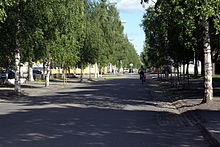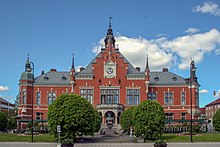Umeå
![]()
This article is about the place Umeå; for the Swedish municipality Umeå see Umeå (municipality).
![]() [ˈʉːmeoː] (local dialect: [ˈʉːmə]), umesam Ubmeje, is a town in the Swedish province of Västerbottens län and historical province of Västerbotten. Umeå is located at the mouth of the river Ume älv on the Gulf of Bothnia and is the county seat and capital of the municipality of the same name.
[ˈʉːmeoː] (local dialect: [ˈʉːmə]), umesam Ubmeje, is a town in the Swedish province of Västerbottens län and historical province of Västerbotten. Umeå is located at the mouth of the river Ume älv on the Gulf of Bothnia and is the county seat and capital of the municipality of the same name.
Umeå is the largest city in Norrland and the thirteenth largest municipality in Sweden with 83,294 inhabitants in 2015. The population has more than doubled since the mid-20th century, making Umeå one of the fastest growing cities in Sweden. The municipality of Umeå had 115,229 inhabitants in 2011. The municipality's goal is to grow to 200,000 inhabitants by 2050.
Umeå is also called the city of birches, since after a devastating fire in 1888 about 3000 birches were planted in the city area. After Luleå, it is Sweden's northernmost university town with two universities and a total of about 37,000 students.
In 2010, Umeå was selected as European Capital of Culture 2014 together with Riga. On 31 January 2014, the European Capital of Culture Umeå was launched, attended by patrons including Crown Princess Victoria and Prince Daniel.

Birch avenue in Umeå

City Hall
History
Stone Age traces can be found in the rock carvings at Norrfors.
Umeå was granted city rights in 1588, but the foundation of the city near the church of Umeå and the associated trading place failed. In 1622 another attempt was made, but it was not until around 1640 that the city began to develop. Umeå became the residential town of the province of Västerbotten. During the Great Northern War at the beginning of the 18th century, the city was burned down by Russian troops in 1714. However, it recovered afterwards and had about 1,000 inhabitants by 1800. In 1809, the last warlike battles on Swedish soil were fought near the town, and the town was again conquered by Russians.
In 1885 Umeå had 2,930 inhabitants. A fire on 25 June 1888 destroyed the town again. 2,500 of the 3,000 inhabitants lost their homes. The birch avenues, for which the town has been famous ever since, were laid out after the fire to make it more difficult for the flames to spread. The city is therefore known throughout Sweden as the "City of Birches". Today there are around 3000 birch trees in Umeå. Due to the northern location, they only sprout around 25 May and lose their leaves again in the second half of September.
In the 20th century the town developed into a service and cultural centre for northern Norrland, also in connection with the founding of Umeå University in 1965.
Coat of arms
Umeå's first coat of arms consisted of three reindeer heads and appeared twenty years after the town was founded in 1622. In 1646, Queen Kristina decreed that the city should have the heads as its coat of arms. Although the motif has been slightly modified up to the present day, it has always been three heads. They have their origin in the coat of arms of the historical landscape of Västerbotten, which depicts a reindeer.
Climate
Umeå has a temperate to cold temperate climate. The proximity to the sea influences the climate, so that the summers and winters are milder than inland.
| Climate table
Source: | ||||||||||||||||||||||||||||||||||||||||||||||||||||||||||||||||||||||||||||||||||||||||||||||||||||||||||||||||||||||||||||||||||||||||||||||||||||||||||||||||||
Search within the encyclopedia